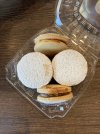Perhaps if you wait until late fall when is rutting season, put a whole deer antler rack on your head, call them with a buck call and stomp your feet and charge at it when you see one you will get some sort of response



No, but I do have a canoe paddle on board that I use often

That will be a really cool project Jer


There is lots of tutorials on youtube to distill the basics of how to go about it.
Perhaps the round stock would be the easiest way to go.
As I understand from the pics Maxi sent me he welds a few plates together and heats/forges all together drawing out the blade and tang. The whole package effectively becomes one piece of steel after the process.
Wait a minute ... another criollo ? ... you are not messing with me right Christian ?


Your post made me recall the outrageously expensive ones I had a few months ago.
They were certainly worth it

I noticed that the handle of my Pampa criollo was a little off center ( as in not aligned with the blade )
I've shared a few pages back how some metal handles are filled with "lacre", a type of cutler's resin.
Here is another video of how one person does it ( this time using a heat gun ). He also show how he pins the tang .
So I contacted a silversmith in Argentina about it.
First he told me no to worry about it

.
He suggested I could dip the handle in very hot water for a little while and then gently try to straighten it.
I decided to just leave it like it is


Today I noticed a couple of tiny pepper spots on my Pampa as I had left it inside the sheath for a while.
I gave it some good TLC, cleaned up the blade, fine tuned the edge and oiled it

The spots are now totally gone and what is left was already there when I bought it

I also made a resolution to be more careful and make sure I don't store carbon blades in their sheaths




























![MEDIA]](/proxy.php?image=http%3A%2F%2F%5BMEDIA%3Dimgur%5DyTN1Nuk%5B%2FMEDIA%5D&hash=7f479a8205050cc5429ef7b629489010)